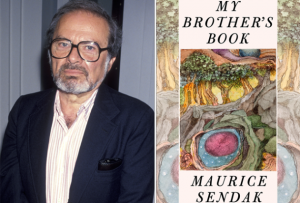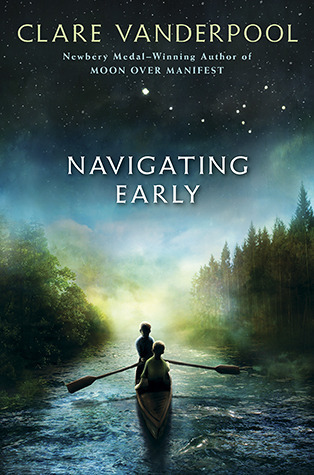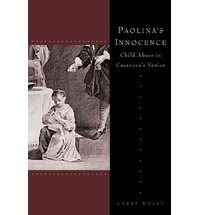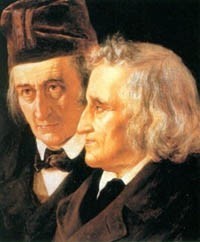Maria Tatar's Blog, page 19
February 6, 2013
Freud’s Wolf Man and “Little Red Riding Hood”
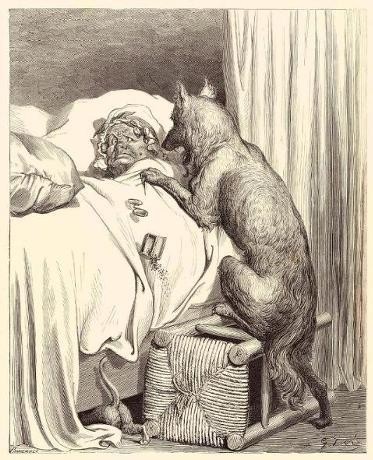 In my course on fairy tales and fantasy literature, we had a session on “Little Red Riding Hood.” I contrasted Dickens’ love of the girl in red ( “Little Red Riding Hood was my first love. I felt that if I could have married Little Red Riding Hood, I should have known perfect bliss.”) with the anxieties of Freud’s Wolf Man (Sergei Pankejeff), who read the story as a child. The Wolf Man, as Freud tells us, was haunted by a dream about wolves, creatures connected with the predator in “Little Red Riding Hood”:
In my course on fairy tales and fantasy literature, we had a session on “Little Red Riding Hood.” I contrasted Dickens’ love of the girl in red ( “Little Red Riding Hood was my first love. I felt that if I could have married Little Red Riding Hood, I should have known perfect bliss.”) with the anxieties of Freud’s Wolf Man (Sergei Pankejeff), who read the story as a child. The Wolf Man, as Freud tells us, was haunted by a dream about wolves, creatures connected with the predator in “Little Red Riding Hood”:
He had always connected this dream with the recollection that during those years of his childhood he was most tremendously afraid of the picture of a wolf in a book of fairy tales. His elder sister, who was very much his superior, used to tease him by holding up this particular picture in front of him so that he was terrified and began to scream. In this picture the wolf was standing upright, striding out with one foot, with its claws stretched out and its ears pricked. He thought this picture must have been an illustration to the story of Little Red Riding Hood.
I have always been on the lookout for that illustration, and I’m wondering if it might not be the one above. I had always pictured the Wolf Man’s creature as full frontal, but now I realize that the description fits Dore’s illustration, even if the wolf has its back turned to us.
Any other candidates?
February 5, 2013
The Last Picture Book
Here’s Tony Kushner on Maurice Sendak as an artist who creates his own fairy tales by taking the raw material of psychic experience and translating it into images and words.
“What I think is great about Maurice is that people who he borrows from are fairly adult artists — William Blake, Herman Melville, William Shakespeare, John Keats, his pantheon of heroes. Mozart, who meant everything to him, and opera in general Maurice really loved — Verdi was a figure that haunted Maurice a lot. … He really wanted to do with this book what he felt Verdi had done at the end of his life with Falstaff. … In his early 80s, Verdi broke a long silence and composed one of the great comic operas, and Maurice was hoping that this book,My Brother’s Book, would be sort of his farewell masterpiece. But I think that the borrowing from these people, his indebtedness to adult artists, is recognizable. He doesn’t really borrow from fairy tales as much as generate his fairy tales from the same sources. His psyche was really an open book.”
http://www.npr.org/2013/02/04/170757799/…
And more in Vanity Fair on Sendak “hiding” in children’s literature and engaging in guerilla warfare.
http://www.npr.org/2013/02/04/170757799/…
January 13, 2013
As If Children Needed a Guide to Anarchy
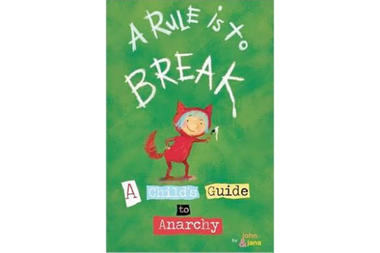 http://www.care2.com/causes/5-subvers...
http://www.care2.com/causes/5-subvers...
Inspired by John Sevan and Jana Christy’s book, Kristina Chew recommends 5 subversive children’s books.
http://www.care2.com/causes/5-subversive…
Number 5 is Greek mythology, and here’s what she has to say about it, I hope she’s not recommending Zeus as a role model.
I’m not thinking of any one book about Greek mythology in particular but of specific ancient Greek texts with the myths. In their original form, these classics are full of violence (often of one family member to another — Oedipus kills his father) and sex (again, of one family member with another — Oedipus again, and numerous others including Zeus and Hera who are siblings and husband and wife).
All of this is presented (in the originals, that is), without moralizing or often without a message that “doing evil means evil will be done to you.” Far from the jolly, Santa Claus-like figure in Disney’s “Hercules” cartoon, Zeus (in the 8th-century poet Hesiod’s Theogony) castrates his father Chronos, who had swallowed Zeus’ mother, Metis, and all of his siblings (including Hera). Greek myths are also steeped in powerful female figures including the goddess of wisdom, Athena, and Hercules (and, for that matter, Zeus) fall in love with as many young men as women.
Historical Fiction for Middle Schoolers
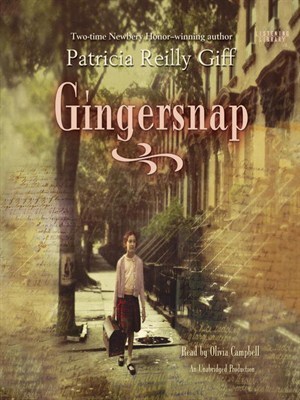
http://www.nytimes.com/2013/01/13/books/…
Jerry Griswold, author of Feeling like a Kid, writes in the New York Times Book Review about two novels set during World War II. I’m glad to see that historical fiction is making a comeback.
January 6, 2013
The Battered-Child Syndrome: 50 Years Later
Larry Wolff, who teaches history at NYU, has written an article for theHuffington Post about the landmark 1962 JAMA report on child abuse.
http://www.huffingtonpost.com/larry-wolf…
Historians suppose that child abuse, both physical abuse (battering) and sexual abuse, were at least as common in past centuries as they are today, but instances were rarely documented, because neither medical nor legal frameworks existed for identifying or discussing them. In fact, child abuse is not abuse unless defined as such, so there is always an element of anachronism in applying the term to the maltreatment of children before 1962, while even today the standard for what constitutes abuse varies widely from culture to culture. I have just written a book about a case that occurred in Venice in the 18th century, when a 60-year-old man was accused of having sex with an 8-year-old girl; he was charged merely with “causing a scandal,” as there was no other plausible criminal charge on the books, and made to pay a fine to the girl’s family. In a notable case in 19th-century New York, the battering of a child could only be prosecuted with reference to the advocacy of the ASPCA and its mandate against cruelty to animals. The publication of the “The Battered-Child Syndrome,” however, offered clinical evidence that child abuse was happening all around us all the time, and began to make us all aware of the huge dimensions of this hitherto-submerged syndrome of shocking but quotidian and recurrent human tragedies.
Below a link to an electronic version of the article in the Journal of the American Medical Association:
http://jama.jamanetwork.com/article.aspx…
And here is its (for the time) daring declaration about a physician’s duty to report certain types of injuries to authorities:
The battered-child syndrome, a clinical condition in young children who have received serious physical abuse, is a frequent cause of permanent injury or death. The syndrome should be considered in any child exhibiting evidence of fracture of any bone, subdural hematoma, failure to thrive, soft tissue swellings or skin bruising, in any child who dies suddenly, or where the degree and type of injury is at variance with the history given regarding the occurrence of the trauma. Psychiatric factors are probably of prime importance in the pathogenesis of the disorder, but knowledge of these factors is limited. Physicians have a duty and responsibility to the child to require a full evaluation of the problem and to guarantee that no expected repetition of trauma will be permitted to occur.
Read Larry Wolff’s case study of how the eighteenth-century handled cases of sexual abuse: Paolina’s Innocence: Child Abuse in Casanova’s Venice.
In the summer of 1785, in the city of Venice, a wealthy 60-year-old man was arrested and accused of a scandalous offense: having sexual relations with the 8-year-old daughter of an impoverished laundress. Although the sexual abuse of children was probably not uncommon in early modern Europe, it is largely undocumented, and the concept of “child abuse” did not yet exist. The case of Paolina Lozaro and Gaetano Franceschini came before Venice’s unusual blasphemy tribunal, the Bestemmia, which heard testimony from an entire neighborhood—from the parish priest to the madam of the local brothel.
Paolina’s Innocence considers Franceschini’s conduct in the context of the libertinism of Casanova and also employs other prominent contemporaries—Jean-Jacques Rousseau, Carlo Goldoni, Lorenzo Da Ponte, Cesare Beccaria, and the Marquis de Sade—as points of reference for understanding the case and broader issues of libertinism, sexual crime, childhood, and child abuse in the 18th century.
January 1, 2013
Wonder in the New Year
If you saw the Les Miserables film, you will know that Gavroche play a far more prominent role in it than in the musical. The child martyr becomes, like Little Nell and Little Eva, the redeemer of adult sinners. And, of course, all the children raised by the evil Thénardiers–in the book Gavroche, Eponine, and Cosette–are heroic figures. Tis the season to think about how we use children to restore our damaged moral sense and our capacity to wonder. I was therefore all the more glad to discover Kevin Lee’s video essay on the Spielberg face, a subject that has always fascinated me. Be sure to scroll down after clicking on the link below to watch the deeply impressive video.
http://www.fandor.com/blog/essential-...
If there is one recurring image that defines the cinema of Steven Spielberg, it is The Spielberg Face. Eyes open, staring in wordless wonder in a moment where time stands still. But above all, a child-like surrender in the act of watching, both theirs and ours. It’s as if their total submission to what they are seeing mirrors our own.
The face tells us that a monumental event is happening; in doing so, it also tells us how we should feel. If Spielberg deserves to be called a master of audience manipulation, then this is his signature stroke. You can’t think of the most iconic moments in Spielberg’s cinema without The Spielberg Face.
December 30, 2012
Arnold Weighs in on the Grimms
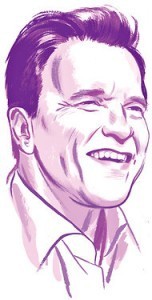 What were your favorite books as a child? Did you have a favorite character or hero?
What were your favorite books as a child? Did you have a favorite character or hero?
When I was young, we were constantly exposed to the works of Peter Rosegger, who was a hero in Styria, my home state. He wrote incredible stories with a focus on our region, so he was one of the favorites.
We also constantly read these terribly violent stories by the Grimm Brothers. I mean, the cleaned-up versions of these are nowhere near the horror stories we used to read. It’s no wonder my brother was a total scaredy-cat and afraid to walk home alone after you realize he had been exposed to the tales of the Grimm Brothers.
http://www.nytimes.com/2012/12/30/books/…
Who knew that Arnold Schwarzenegger would be the go-to guy for what to read next? I cannot help but think of Neil Gaiman’s wonderful line about his own craft every time I see a picture of the Governor/Terminator: “I make things up and write them down.”
December 22, 2012
Marina Warner brings us Grimm Thoughts on the BBC
Here’s the link to the 10-part BBC broadcast on the Brothers Grimm
http://www.bbc.co.uk/programmes/b01pjjzs…
Episode 10
Marina Warner considers the future of the Grimm brothers’ tales.
Marina Warner examines the tales’ history of censorship.
First broadcast: 27 Dec 2012
Marina Warner explores the Grimm brothers’ tales.
First broadcast: 26 Dec 2012
Episode 7
Marina examines the deeper meanings read into the tales by writers and psychologists.
First broadcast: 25 Dec 2012
Episode 6
Marina Warner probes the fate of the tales at the hands of the Nazis.
First broadcast: 24 Dec 2012
Episode 5
Marina Warner is drawn into the tales’ rich history of illustration.
First broadcast: 21 Dec 2012
Marina identifies real people and places believed to have inspired the Grimms’ collection
Episode 3
3/10 Marina Warner enters the magical worlds of the fairy tale.
First broadcast: 19 Dec 2012
2/10 Marina Warner traces Grimms’ tales back to their ancient origins.
First broadcast: 18 Dec 2012
Episode 1
1/10 Marina Warner introduces the Grimm brothers and examines the story of The Frog King.
First broadcast: 17 Dec 2012
December 15, 2012
What to Pack?
http://www.theonion.com/articles/the-hob…
‘The Hobbit’ To Feature 53-Minute-Long Scene Of Bilbo Baggins Trying To Figure Out What To Pack
The film, one of three upcoming Lord Of The Rings prequels based on the novel by J.R.R. Tolkien, reportedly suspends its main narrative action for almost a third of its screen time while the main character rummages through his house trying to figure out what clothing and personal possessions he will need for his journey.
“Yeah, he just sort of fusses around for a while, wondering aloud whether he should pack an umbrella or not, and laying out different coats on his bed,” said Hollywood Reporter critic Todd McCarthy, who attended an early press screening this week. “And then there are long stretches—I’m talking like 10, 12 minutes—where he’s just sitting in a chair silently thinking about what he’s going to need.”
November 28, 2012
Making Sense of Classic Fairy Tales
Maria Tatar's Blog
- Maria Tatar's profile
- 316 followers


